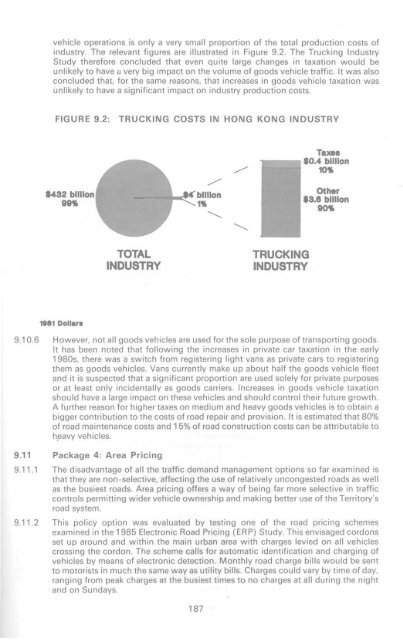Untitled - HKU Libraries - The University of Hong Kong
Untitled - HKU Libraries - The University of Hong Kong
Untitled - HKU Libraries - The University of Hong Kong
- No tags were found...
Create successful ePaper yourself
Turn your PDF publications into a flip-book with our unique Google optimized e-Paper software.
vehicle operations is only a very small proportion <strong>of</strong> the total production costs <strong>of</strong>industry. <strong>The</strong> relevant figures are illustrated in Figure 9.2. <strong>The</strong> Trucking IndustryStudy therefore concluded that even quite large changes in taxation would beunlikely to have a very big impact on the volume <strong>of</strong> goods vehicle traffic. It was alsoconcluded that, for the same reasons, that increases in goods vehicle taxation wasunlikely to have a significant impact on industry production costs.FIGURE 9.2: TRUCKING COSTS IN HONG KONG INDUSTRYTaxes$0.4 billion10%$432b.mon ___ ^bffllon ' $a?b5on^1% 90%TOTALINDUSTRYTRUCKINGINDUSTRY1981 Dollars9.10.6 However, not all goods vehicles are used for the sole purpose <strong>of</strong> transporting goods.It has been noted that following the increases in private car taxation in the early1980s, there was a switch from registering light vans as private cars to registeringthem as goods vehicles. Vans currently make up about half the goods vehicle fleetand it is suspected that a significant proportion are used solely for private purposesor at least only incidentally as goods carriers. Increases in goods vehicle taxationshould have a large impact on these vehicles and should control their future growth.A further reason for higher taxes on medium and heavy goods vehicles is to obtain abigger contribution to the costs <strong>of</strong> road repair and provision. It is estimated that 80%<strong>of</strong> road maintenance costs and 15% <strong>of</strong> road construction costs can be attributable toheavy vehicles.9.11 Package 4: Area Pricing9.11.1 <strong>The</strong> disadvantage <strong>of</strong> all the traffic demand management options so far examined isthat they are non-selective, affecting the use <strong>of</strong> relatively uncongested roads as wellas the busiest roads. Area pricing <strong>of</strong>fers a way <strong>of</strong> being far more selective in trafficcontrols permitting wider vehicle ownership and making better use <strong>of</strong> the Territory'sroad system.9.11.2 This policy option was evaluated by testing one <strong>of</strong> the road pricing schemesexamined in the 1985 Electronic Road Pricing (ERP) Study. This envisaged cordonsset up around and within the main urban area with charges levied on all vehiclescrossing the cordon. <strong>The</strong> scheme calls for automatic identification and charging <strong>of</strong>vehicles by means <strong>of</strong> electronic detection. Monthly road charge bills would be sentto motorists in much the same way as utility bills. Charges could vary by time <strong>of</strong> day,ranging from peak charges at the busiest times to no charges at all during the nightand on Sundays.187
















